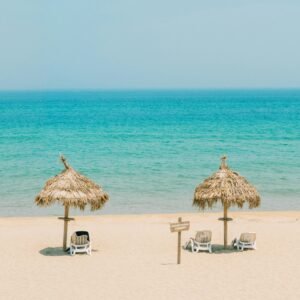When we think of beaches, we usually imagine white sands, crystal-clear waters and moments of relaxation. However, some of the planet’s most breathtaking coastlines hide natural hazards and threats that make them dangerous places for visitors. From treacherous currents to lethal wildlife, these beaches require extreme caution.
1. Death Beach, Oaxaca, Mexico.
Famous for its beauty, but with extremely dangerous currents and waves that have claimed numerous lives.
2. New Smyrna Beach, Florida, United States.
Nicknamed the “shark attack capital of the world” due to the high concentration of incidents each year.
3. Fraser Island, Queensland, Australia.
In addition to sharks and poisonous jellyfish, it is home to wild dingoes that can attack visitors.
4. Hanakapiai Beach, Hawaii, United States.
Turquoise waters but with extremely strong rip currents and no lifeguards.
5. Gansbaai, South Africa.
Known as the home of the great white shark, one of the most feared predators in the ocean.
6. Chowpatty Beach, Bombay, India.
Heavily polluted and with serious health risks for those who bathe in it.
7. Kilauea Beach, Hawaii, United States.
Located next to an active volcano, its black sands and warm waters hide the danger of sudden eruptions.
8. Skeleton Coast Beach, Namibia.
Known for shipwrecks and the presence of predators such as sharks and aggressive sea lions.
9. Zipolite Beach, Oaxaca, Mexico.
Popular with backpackers, but with very dangerous undercurrents.
10. Beach of Uluwatu, Bali, Indonesia.
Perfect waves for experienced surfers, but treacherous for inexperienced swimmers due to currents.
11. Boa Viagem Beach, Recife, Brazil.
Warm and paradisiacal waters, but with a high presence of bull sharks, responsible for numerous attacks.
12. Cable Beach, Broome, Australia.
Frequented by deadly jellyfish such as the sea wasp, as well as sharks and crocodiles.
13. Dumas Beach, Gujarat, India.
Surrounded by legends and considered haunted, it is also dangerous due to its currents and lack of security.
14. Amazon Beach, Brazil.
Close to areas inhabited by piranhas and freshwater stingrays, which can be lethal.
15. Tamarama Beach, Sydney, Australia.
Small but with very strong waves and currents, even for expert swimmers.
16. Monastery Beach, California, United States.
Known for its strong undertow and waves that hit the shore directly, dragging swimmers.
17. Arugam Bay Beach, Sri Lanka.
In addition to dangerous currents, it is in an area prone to tsunamis.
18. Boulders Beach, South Africa.
Home to penguin colonies, but also to sharks that roam the area.
19. Dumas Beach, Tamil Nadu, India.
Coastal area with strong currents and considered high risk by local fishermen.
20. Huaian Beach, China.
Frequently in the news for incidents with unpredictable tides and currents that trap tourists.
Conclusion.
These beaches remind us that natural beauty can be accompanied by deadly risks. Before visiting any coastal destination, it is essential to be informed about its conditions, respect the warnings and never underestimate the strength of the sea or the presence of dangerous fauna. Enjoying paradise is possible, as long as we do it with respect and caution.


